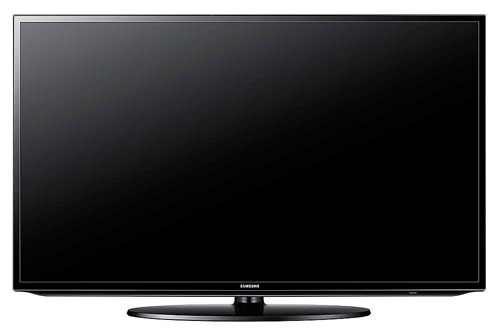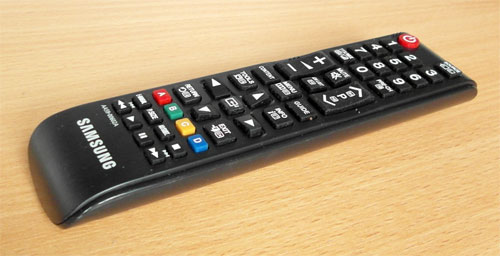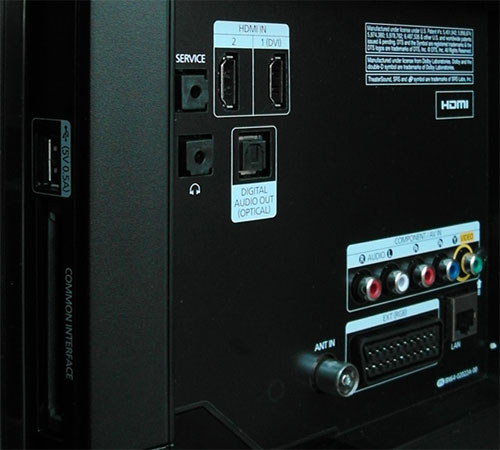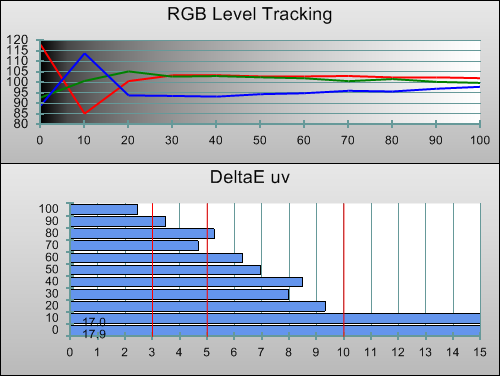For the second year running, it’s only around this time in December – when most of the TVs have been covered and the gongs awarded – that we get around to reviewing an entry-level offering from Samsung Electronics, the world’s largest television manufacturer. For 2012, this comes in the form of the UE32EH5000, a 32-inch direct LED-lit LCD TV with full HD 1920×1080 screen resolution.
Compared to last year’s equivalent model (the UE32D5000), the 32″ EH5000 has gained Freeview HD support via an integrated DVB-T2 tuner, but lost two HDMI ports (down from 4 to 2). Priced at below £300 online at this time of writing, the display won’t break the bank too, but is it value for money, or just false economy? We’re about to find out…
Note: The sample we tested was the Samsung UE32EH5000KXXU (the 3-pin-plug United Kingdom model), version number 01. According to the service menu, it uses a Chi Mei LCD panel.
Upon unpacking the TV for assembly, we experienced a throwback to the days before super-slim LED televisions became all the rage – the Samsung UE32EH5000 sports one of the bulkiest backside we’ve seen on a flat-panel HDTV in a long while. Were it not for the “LED TV” label on the box, the 32EH5000 could very well pass for a more traditional CCFL-backlit LCD television.

But since we do not watch TV from the sides, we were totally unfazed by the set’s chunkier form factor. From the front, the LCD screen is coated with a sheen that is halfway between matte and reflective, which shouldn’t pose a problem even in the brightest of rooms. This is in turn framed by a thin bezel finished in glossy black, matching the coating on the pedestal stand’s oval base.

The supplied remote control is small and functional. The rubbery buttons do not give particularly good tactile feedback, nor are they backlit. The overall quality and feel is in keeping with the UE32EH5000’s budget proposition.
 |
| 2 x HDMI, USB, CI slot, Component, SCART, aerial, ethernet & audio outs |
Hoping to obtain a greyscale that’s closest to D65 industry standard out of the box, we popped the Samsung EH5000 into [Movie] mode, with [Colour Tone] left at its default setting of “Warm2“. Here’s what we got:
 |
| Pre-calibration RGB tracking and delta errors (dEs) |
For the most part blue channel was underfilled, causing what should be neutral shades of grey to take on a red tint. Fortunately the LED LCD TV comes with 2-point white balance controls in its user menu, allowing us to address the issue.
![Post-calibration RGB Tracking in [Movie] mode](https://www.hdtvtest.co.uk/news/wp-content/uploads/2018/04/hdtv_Samsung-UE32EH5000_post-rgb.png) |
| Post-calibration RGB tracking and dEs in [Movie] mode |
After some brief adjustments, the on-screen picture looked much healthier. Delta errors (dEs) were reduced to below 2 from 30% stimulus onwards, which is very good going for a sub-£300 television.
Prior to calibration, overall gamma in [Movie] mode was measured to be higher than the 2.4 reference we now aim for. Low-end gamma even exceeded 2.5 at certain points, which would cause shadow detail to be obscured.
| Post-calibration gamma in [Movie] mode | Corresponding gamma tracking |
The UE32EH5000 features a single [Gamma] control that lets you raise or lower the gamma across the entire luminance range. We changed its value to “1” to bring gamma in line with our 2.4 target. Due to the absence of 10-point gamma or white balance controls, we could not flatten the slight bump at 10% stimulus (read: shadow detail will look darker than it should be) nor the dip at 90% stimulus (i.e. bright highlight will look brighter than it should be), but these are minor shortcomings in the grand scheme of things considering the price of the display.
The Samsung 32EH5000 offers two [Colour Space] presets: “Auto” and “Native“. Of the two, the former is more accurate – the latter yielded a pale, bluish green that looked sickly.
![[Colour Space] Auto](https://www.hdtvtest.co.uk/news/wp-content/uploads/2018/04/hdtv_Samsung-UE32EH5000_cie-auto.jpg) | ![[Colour Space] Native](https://www.hdtvtest.co.uk/news/wp-content/uploads/2018/04/hdtv_Samsung-UE32EH5000_cie-native.jpg) |
| [Colour Space] “Auto” | [Colour Space] “Native” |
Given the omission of a colour management system (which is presumably reserved for more expensive, step-up models), the only controls we had available at our disposal to affect proceedings were the [Colour] and [Tint] sliders. Following greyscale calibration, the secondary colour hues fell into place quite nicely, so we left [Tint] unchanged at its default value of “G50/R50“, and only had to contend with [Colour].
The quandary is that [Colour] affects both colour saturation and luminance at the same time, therefore settling on a value became a fine balancing act. Normally we prioritise getting colour luminance (also known as colour decoding/ brightness/ intensity) right, particularly for red primary since red push can stick out like a sore thumb to discerning viewers.
However, on the Samsung UE32EH5000 we found that colours tended to run “hot” (that is, they appeared more saturated than they should be) at sub-100% saturation intervals, so we decided to dial [Colour] down a notch, which as it turned out did not negatively impact colour decoding in a significant manner.
| Post-calibration CIE chart with saturation tracking |
![Post-calibration Luminance levels in [Movie] mode](https://www.hdtvtest.co.uk/news/wp-content/uploads/2018/04/hdtv_Samsung-UE32EH5000_post-colour-lum.png) |
| Post-calibration colour luminance (coloured bars = targets; black bars = measured values) |
| Dead pixels | None |
| Screen uniformity | Very good for an LCD TV panel |
| Overscanning on HDMI | 0% with “Screen Fit” selected |
| Blacker than black | Passed |
| Calibrated black level (black screen) | 0 cd/m2 (LEDs shut off) |
| Calibrated black level (ANSI checkerboard) | 0.035 cd/m2 |
| Black level retention | Auto-dimming with full black screen |
| Primary chromaticity | Decent |
| Scaling | Excellent, smooth |
| Video mode deinterlacing | Very effective jaggies reduction |
| Film mode deinterlacing | Passed 3:2 and 2:2 cadences with [Film Mode] engaged |
| Viewing angle | Decent for an LCD TV |
| Motion resolution | 300 |
| Digital noise reduction | Optional |
| Sharpness | Defeatable edge enhancement |
| 1080p/24 capability | Very mild judder – negligible at this screen size |
| Input lag | 20ms compared to lag-free CRT |
| Full 4:4:4 reproduction (PC) | Yes, with input label set to [PC] |
| Default [Standard] mode | 44 watts |
| Calibrated [Movie] mode | 33 watts |
| Standby | <1 watt |
Note: Measurements taken with full-field 50% grey screen.
| Jump To: 1. Design & CalibrationNext: Performance |
jQuery(document).ready(function($) { var toc = $("#tableofcontents").html(); $("#tablecontents").html(toc); });